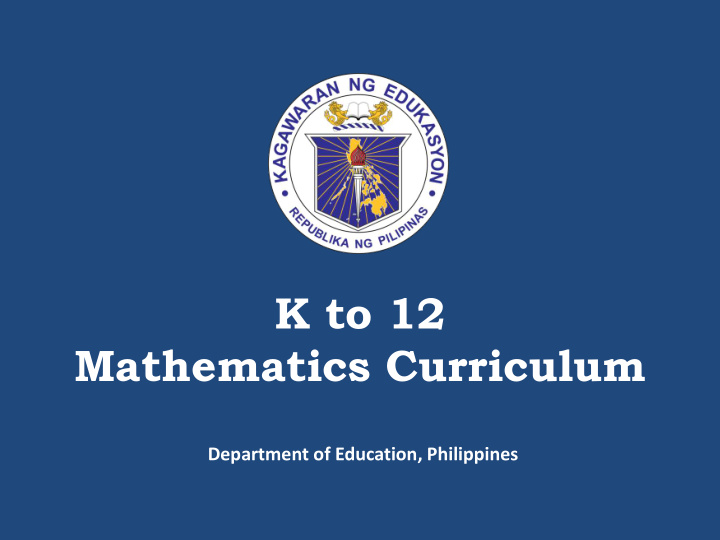



K to 12 Mathematics Curriculum Department of Education, Philippines
A. Conceptual Framework DEPARTMENT OF EDUCATION
Features of the Curriculum Guide (CG) A . Conceptual Framework B. Learning Standards • Learning Area Standard • Description • Key Stage Standards • Goals • Grade Level Standards • Content Areas - Content/Strand • Skills and Processes - Content Standards • Values and Attitudes - Performance Standards • Mathematical Tools - Learning Competencies • Context (with codes and available learning • Theories and Principles materials) Glossary Code Book Legend DEPARTMENT OF EDUCATION
Key Stage Standards DEPARTMENT OF EDUCATION
Grade Level Standards DEPARTMENT OF EDUCATION
Development of Learner’s Materials (LMs) and Teaching Guides (TGs)
The Development Process CURRICULUM GUIDE Content Standards Performance Standards Learning Competencies Format/ Design General Guidelines and Principles for of LM and TG Instructional Materials Development LM/TG Development (WRITING PROCESS) Validation of LM/TG Review of LM/TG Refinement of (Quality Circle Reviewers) LM/TG Finalization of LM/TG DEPARTMENT OF EDUCATION
Format/Design I. Introduction II. Learning Competencies/Objectives III. Pre-/Diagnostic Assessment (LM and TG) IV. Reading Resources/Instructional Activities A. What to KNOW? B. What to PROCESS? C. What to REFLECT or UNDERSTAND? D. What to TRANSFER? V. Summative Assessment (TG only) VI. Summary/Synthesis/Feedback Glossary of terms References and other reading materials (Print and Non-print) DEPARTMENT OF EDUCATION
Development of LM/TG PERSONS INVOLVED: Practitioners (DepEd teachers/ master teachers/ head teachers/supervisors and private school teachers) Content Consultants DEPARTMENT OF EDUCATION
Validation of LM/TG DEPARTMENT OF EDUCATION
Refinement of LMs/TGs Output: PERSONS INVOLVED: Revised LM/TG based on the comments/ Writers suggestions and Consultants recommendations of the validators/ reviewers Representatives upon agreement with the from the group of writers and consultants. validators DEPARTMENT OF EDUCATION
Review of LMs/TGs (Quality Circle Reviewers) Persons Involved: Quality Circle Reviewers (invited by IMCS) Language Editors (c/o IMCS) Outputs: Comments/Suggestions/ Recommendations on the Content of the LMs/TGs Language Edited LMs/TGs DEPARTMENT OF EDUCATION
Finalization of LMs/TGs DEPARTMENT OF EDUCATION
Assessment
Classroom Assessment • Tracks learners progress • Feedback • Report DEPARTMENT OF EDUCATION
Classroom Assessment What is assessed in the classroom? • Content Standards • Performance Standards • Learning Competencies • Concept Development DEPARTMENT OF EDUCATION
Classroom Assessment Types of Assessment? • Formative Assessment o Before the lesson o During the lesson o After the lesson • Summative Assessment o Written Work o Performance Task o Quarterly DEPARTMENT OF EDUCATION
National Assessment National Achievement Test (NAT) Grades 6 and 10 • National Career Assessment Examination (NCAE) Grade 9 • DEPARTMENT OF EDUCATION
Sample Curriculum Guide for Grade 7 - Mathematics
Grade 7 Mathematics Content Performance Learning Competency Standards Standards Content Code The learner... The learner... The learner... 1. translates English Patterns and demonstrates is able to model phrases to mathematical M7AL-IIc-1 Algebra understanding of situations using phrases and vice versa. key concepts of oral, written, 2. interprets the meaning of algebraic graphical, and a n where n is a positive M7AL-IIc-2 expressions, the algebraic methods integer. properties of real in solving problems 3. differentiates between numbers as involving algebraic constants and variables in M7AL-IIc-3 expressions, linear applied in linear a given algebraic equations, and equations, and expression. inequalities in one inequalities in one 4. evaluates algebraic variable. variable. expressions for given M7AL-IIc-4 values of the variables. DEPARTMENT OF EDUCATION
Grade 7 Mathematics Content Performance Content Learning Competency Code Standards Standards 5. classifies algebraic expressions which are polynomials according to M7AL-IId-1 degree and number of terms. 6. adds and subtracts M7AL-IId-2 polynomials. 7. derives the laws of M7AL-IId-e-1 exponent. 8. multiplies and divides M7AL-IIe-2 polynomials. DEPARTMENT OF EDUCATION
Grade 7 Mathematics Content Performance Content Learning Competency Code Standards Standards 9. uses models and algebraic methods to find the: (a) product of two binomials; (b) product of the sum and difference of two terms; (c) M7AL-IIe-g-1 square of a binomial; (d) cube of a binomial; (e) product of a binomial and a trinomial.*** 10. solves problems involving M7AL-IIg-2 algebraic expressions. 11. differentiates between algebraic expressions and M7AL-IIh-1 equations. DEPARTMENT OF EDUCATION
Grade 7 Mathematics Content Performance Content Learning Competency Code Standards Standards 12. translates English sentences to mathematical sentences M7AL-IIh-2 and vice versa. 13. differentiates between M7AL-IIh-3 equations and inequalities. 14. illustrates linear equation and inequality in one M7AL-IIh-4 variable. 15. finds the solution of linear equation or inequality in M7AL-IIi-1 one variable. DEPARTMENT OF EDUCATION
Grade 7 Mathematics Content Performance Content Learning Competency Code Standards Standards 16. solves linear equation or inequality in one variable involving absolute value by: M7AL-IIi-j-1 (a) graphing; and (b) algebraic methods. 17. solves problems involving equations and inequalities M7AL-IIj-2 in one variable. DEPARTMENT OF EDUCATION
Issues and Challenges in Mathematics Curriculum Reform
Issues and Concerns in Mathematics Curriculum Reform • Creativity to think out of the box • Spiral progression Need to review and relearn - mathematics strands Support for capacity building - • Proper use of technology DEPARTMENT OF EDUCATION
Suggestions on SEA-BES Common Core Regional learning Standards (CCRLS)
Suggestions on SEA-BES Common Core Regional Learning Standards (CCRLS) 1. Pilot test of the CCRLS among SEAMEO member countries at least for a year. 2. Benchmarking to share best practices. 3. Institutionalizing the use of CCRLS among SEAMEO member countries . DEPARTMENT OF EDUCATION
Thank you! hank you!
Recommend
More recommend